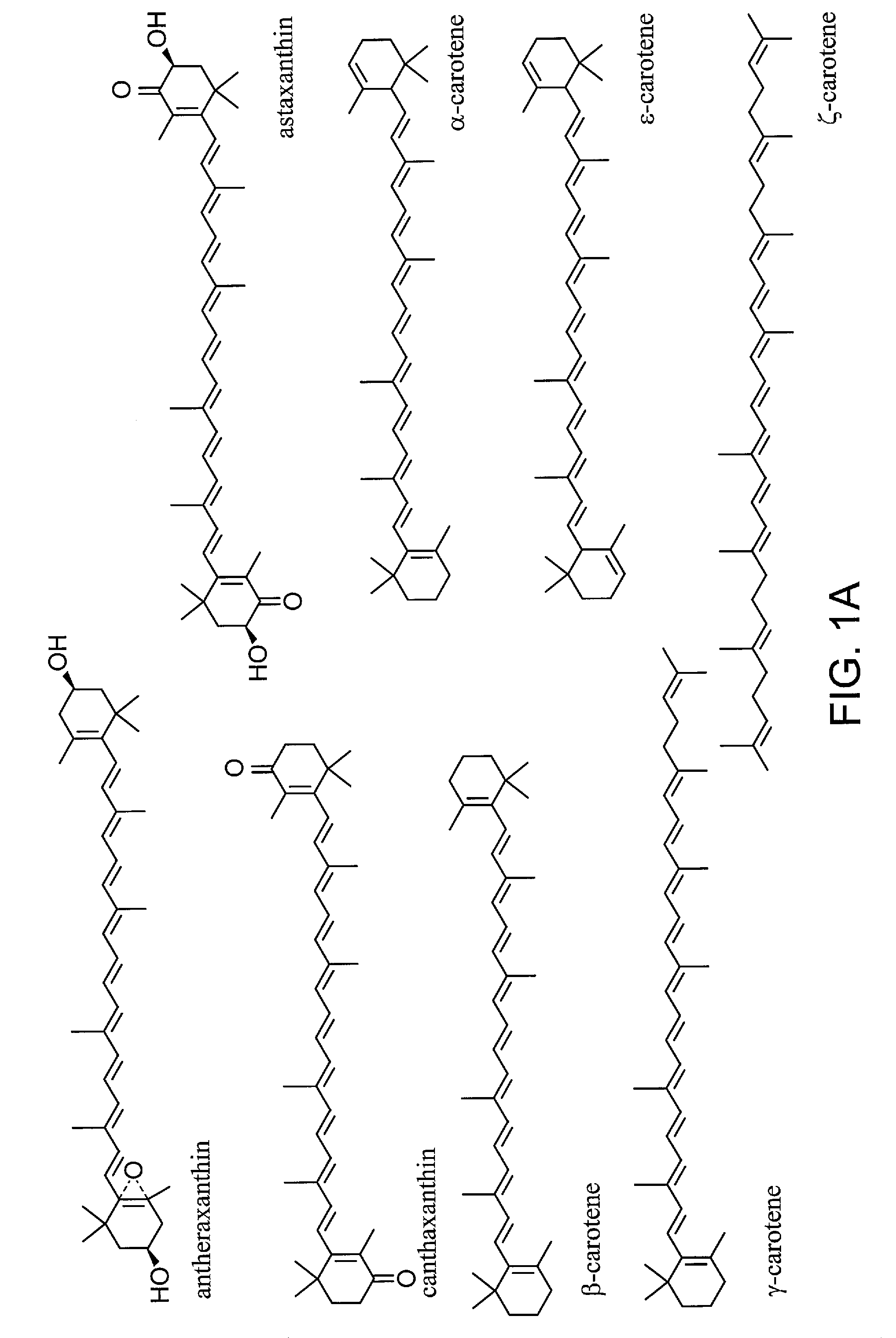Production of carotenoids in oleaginous yeast and fungi
a technology of oleaginous yeast and carotenoids, which is applied in the field of production of carotenoids in oleaginous yeast and fungi, can solve the problems of inability of animals to produce carotenoids and commercial scale isolation is not practicable, and achieve the effect of enhancing oleaginicity and altering carotenoid-producing capabilities
- Summary
- Abstract
- Description
- Claims
- Application Information
AI Technical Summary
Benefits of technology
Problems solved by technology
Method used
Image
Examples
example 1
Production of Plasmids for Carotenoid Strain Construction
[0111]Plasmids were generated for construction of carotenoid producing strains. The following subparts describe production of plasmids encoding carotenogenic polypeptides. Plasmids used in these studies and details of their construction are described in Table 27. Additional plasmid construction details and descriptions of their use are found in the text of the relevant subsection. All PCR amplifications used NRRL Y-1095 genomic DNA as template unless otherwise specified. The URA5 gene described below is allelic with the ura2-21 auxotrophy above. The GPD1 and TEF1 promoters are from Y. lipolytica as is the XPR2 terminator.
[0112]GGS1 is the gene encoding the Y. lipolytica gene encoding geranylgeranylpyrophosphate synthase. The nucleic acid coding sequence, and encoded Ggs1 protein of pMB4591 and pMB4683 are as follows:
[0113]
atggattataacagcgcggatttcaaggagatatggggcaaggccgccgacaccgcgctgctgggaccgtacaactacctcgccaacaacc...
example 2
Engineering Yarrowia lipolyvtica for Increased Carotenoid Production
[0140]2A. Production of Y. lipolytica expressing geranylgeranylpyrophosphate synthase and phytoene dehydrogenase: MF350 (MATB ura2-21 leu2-35 ade1) was transformed with pMB4591 (tef1p-GGS1) that had been cleaved upstream of URA5 with SspI; a Ura+ transformant carrying the plasmid at the ura2 locus was identified and named MF364. It was subsequently transformed with pMB4638 (tef1p-carB) that had been cleaved at ADE1 with SspI and a prototrophic transformant was chosen that harbored the plasmid at the ade1 locus. This strain was named MF502.
[0141]2B. Production of Y. lipolytica expressing geranylgeranylpyrophosphate synthase, phytoene dehydrogenase and phytoene synthase / lycopene cyclase MF502 was transformed with pMB4628 (tef1p-carRP) that had been treated with SspI. Nine prototrophic colonies were chosen that were uncolored, orange, or very orange on the transformation plate (YNB agar with 1% glucose and 0.1% glutama...
example 3
Extraction of Carotenoids from Yarrowia lipolytica Cells
[0146]Shake-flask testing of generated strains was conducted using YPD medium (1% yeast extract, 2% peptone, 2% glucose). 20 ml cultures in 125 ml flasks were grown at 30° C. Y. lipolytica cells were harvested from 72-96 hour cultures, and extractions were performed to determine carotenoid form and quantity. 1.8 ml of culture was placed into an Eppendorf tube. Cells were pelleted and washed twice with 1 ml H2O. After the second wash, the resuspended cells were transferred to a pre-weighed snap-cap tube with a hole poked in the top, and the cells were lyophilized overnight. After drying to completion, the tube was weighed in order to calculate dry cell weight. 0.25 ml from the same shake flask culture was placed into a 2 ml screw-cap tube for carotenoid extraction. Cells were pelleted and the supernatant was aspirated. Pelleted cells may be frozen at −80° C. and stored. An equal volume of cubic zirconia beads was added to cell p...
PUM
| Property | Measurement | Unit |
|---|---|---|
| temperatures | aaaaa | aaaaa |
| dry cell weight | aaaaa | aaaaa |
| dry cell weight | aaaaa | aaaaa |
Abstract
Description
Claims
Application Information
 Login to View More
Login to View More - R&D
- Intellectual Property
- Life Sciences
- Materials
- Tech Scout
- Unparalleled Data Quality
- Higher Quality Content
- 60% Fewer Hallucinations
Browse by: Latest US Patents, China's latest patents, Technical Efficacy Thesaurus, Application Domain, Technology Topic, Popular Technical Reports.
© 2025 PatSnap. All rights reserved.Legal|Privacy policy|Modern Slavery Act Transparency Statement|Sitemap|About US| Contact US: help@patsnap.com



